|
Northern Chile
I leave Bolivia
I was in no hurry to leave the next morning. I ate vegetable soup for breakfast. Then I spent all my money on a modest range of biscuits, keeping only 35 Bol. for the exit fee to leave the country. The border was just a few miles up a slight hill, there was no rush. When I arrived at the Customs office, some tourists started to applaud me, but I was already used to that. Two soldiers took care of the administrative tasks. They were very cheerful and keen to know where I had been cycling. They stamped my passport, did not want any money and shook hands with me. I, guided by a momentary impulse, stood to attention and shouted: “Viva Bolivia!” and they also stood up and saluted me. Evo Morales would have rejoiced to see this. Outside, I was also grabbed by the tourists and had to undergo the necessary photo-taking which ensued.
Then I spun the pedals a few more times before reaching Chile. Although the road was dusty, the sand had more or less been swept away. The path led uphill, but I was not rushing to get anywhere. I just did not know where the Chilean passport control was. Finally, I found it as far away as in San Pedro de Atacama. The dusty road led to a perfect paved road and the nearly 40-km long downhill ride started, dropping more than 2,000 meters in altitude. A strong gusty wind was blowing, so I applied the brakes a lot. I stopped three times along the way, to allow the heated wheel rims to cool down, they were not white-hot, but still quite hot. A lot of trucks drove by, as the road connects Chile with Argentina as well. There were a series of deceleration strips on the side of the road, yet I saw many charred wrecks along the way.
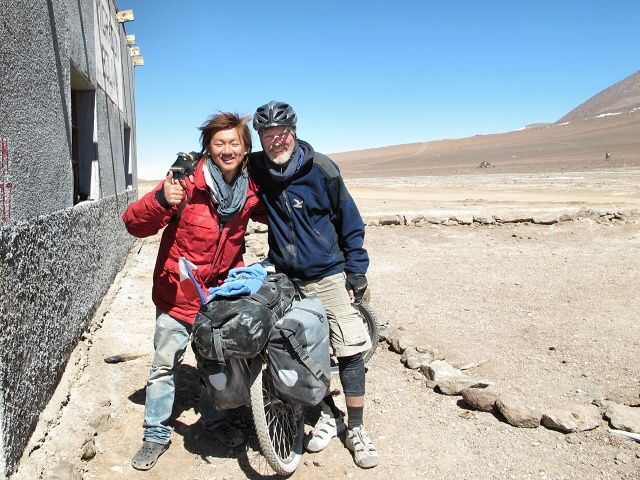
[Bolivian and Chilean border] Tourists liked to be photographed with me
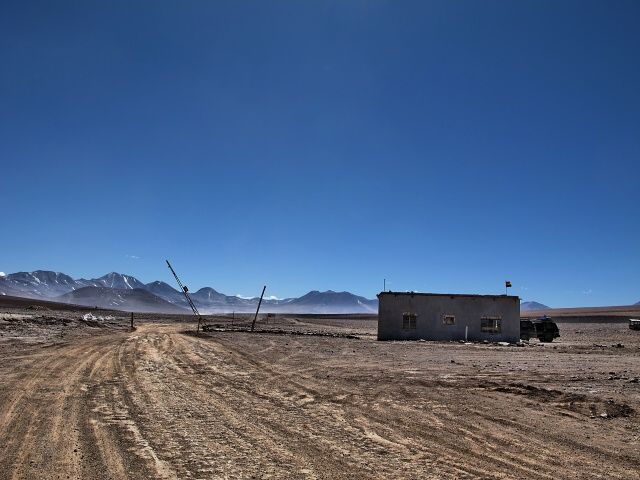
[Bolivian and Chilean border] Last glance at Bolivia
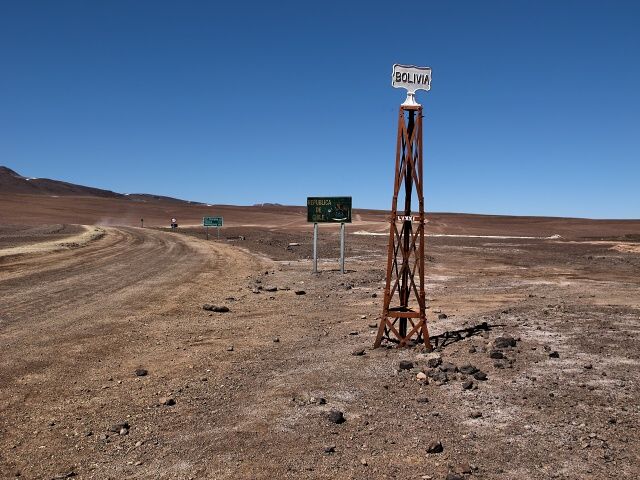
[Bolivian and Chilean border] And now up to Chile!
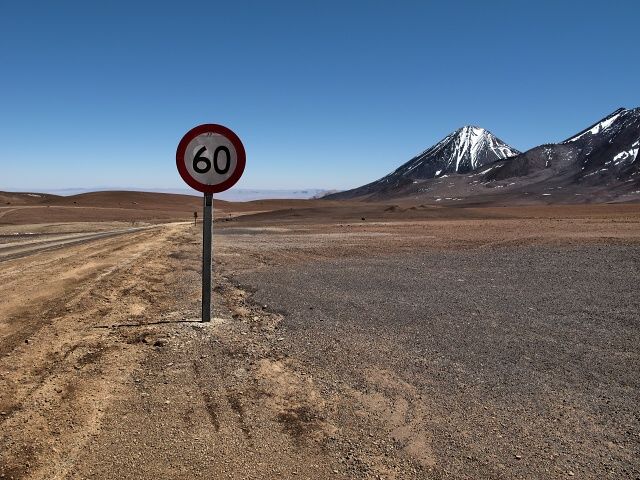
[Bolivian and Chilean border] Licancabur Volcano is nearby, but it strikingly dominates the landscape even in San Pedro de Atacama – 40 km away

[Near San Pedro de Atacama] Within 40 km, the road dropped 2000 meters in altitude
Heaven, I'm in heaven
…as Fred Astaire once sang. After my arrival in San Pedro de Atacama I also felt as if in heaven. The warmth, people in short-sleeved T-shirts. The air was solid and dense (2,500 meters above sea level) which did not provoke tuberculosis-like coughing. All around were many pubs and food stores, real balm for my starving body. According to the Guide, the problem with the two local ATMs was that they often did not have enough cash. It was Sunday, but the first ATM gave me the required 80,000 Pesos (the exchange rate is about 0.2 USD to 100 Pesos). The only criterion for finding accommodation was WiFi in the room. I found this easily, pushed the bike into the room and started the cleaning. The first 15 minutes were spent in a hot shower. Then I gave the receptionist a big bag of dirty clothes to be washed. Then I found a tap in the yard and a hosepipe, asked permission to use it (there are big water shortage problems, so this is a sensitive issue). I gradually washed the coat of dust and salt from all the bags, thoroughly scrubbed the bike and oiled everything. The SPD pedals were in the worst state, cemented with salt and fine sand. I had to clean them by hand with a small screwdriver. It would have been best to have taken them off, soaked them in kerosene for a day and then scoured them with a wire brush.
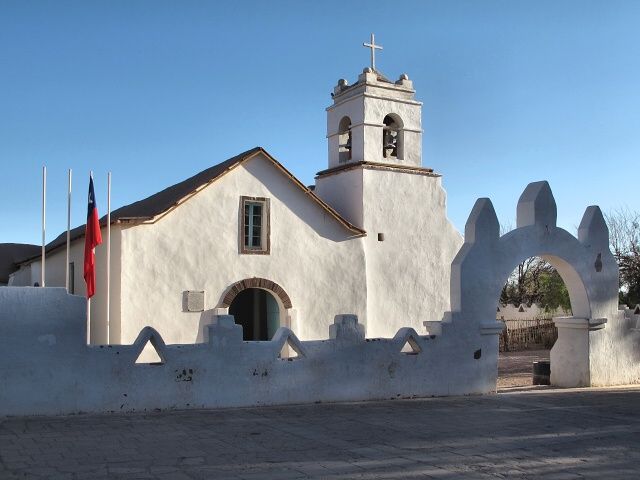
[San Pedro de Atacama ] A neat church
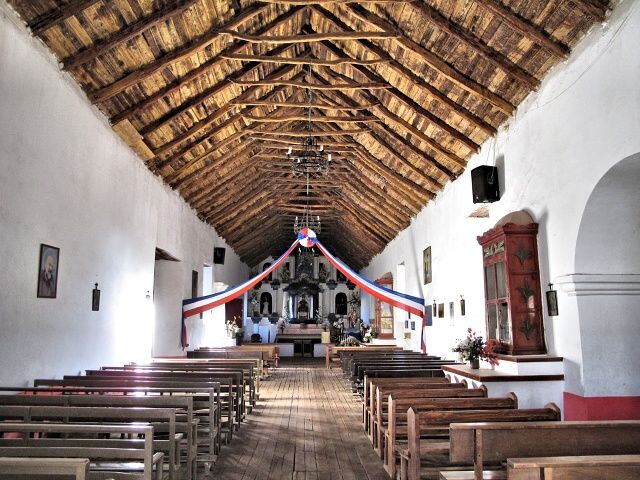
[San Pedro de Atacama ] The roof frame of the church made of porous cactus wood
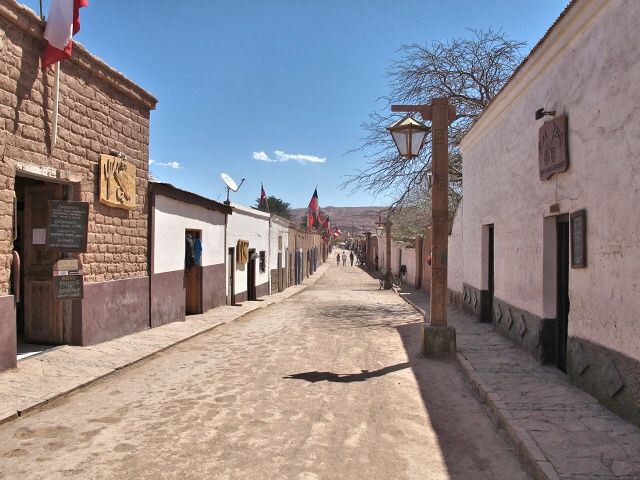
[San Pedro de Atacama] The main shopping street of Caracoles livens up in the evenings
Convalescence
Only the next morning after waking up, did I realize that I was hungry and tired. I bought a huge breakfast, washed down with two liters of tea and decided to take advantage of being in a “tourist village” and so behaved accordingly. I went to travel agencies, bought a four-hour trip to the Moon Valley for the afternoon and a trip to the Geysers for the next day.
Meanwhile, I learnt that the Chilean state is no idiot and knows how to guard its tax revenues. Every little merchant who accepts cash has an oblong pad with printed company data. I think each page has eight strips on which the amount is written. The customer gets a copy while the original remains in the pad. With every purchase, you get a receipt copy. This seems to be strictly controlled. It never ever happened that I paid and left without a receipt. The financial authorities have a perfect overview of the income of each company. I suppose it is possible to use a cash register with the fiscal module, then it would not be necessary to write out individual receipts. A few years ago, cash registers were introduced as obligatory for everybody who receives cash in the Czech Republic. This means that even an old woman who sells in the marketplace and has a monthly income of 50 USD is obliged to buy a cash register and perhaps carry it in the basket together with the carrots she sells. Nobody has thought of the simple paper-based Chilean solution, perhaps because no fat commission can be earned from the printing of receipt pads.
Moon Valley
This is situated about 16 km from San Pedro. I could have cycled there, but it would have been arduous in the canyon, among the dunes etc. However, I could could get there by bus. The guide always led us through part of the valley and the bus waited ahead to take us to the next attraction. The explanation was in Spanish and English and I have to say that the guide tried very hard. Besides Moon Valley, we visited the Valley of the Dead, where there is an impressive deep hole in the ground as if a small atomic bomb had exploded there. We saw several interesting rocky formations, former salt mines. The final attraction was watching the sunset, during which the color and the overall atmosphere of the rim of the surrounding mountains were gradually transformed.
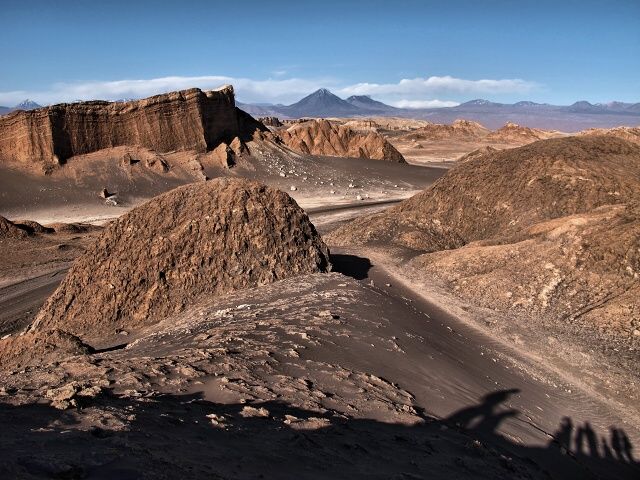
[Valle de la Luna] A rock formation called Amphitheatre up on the left; trippers down on the right
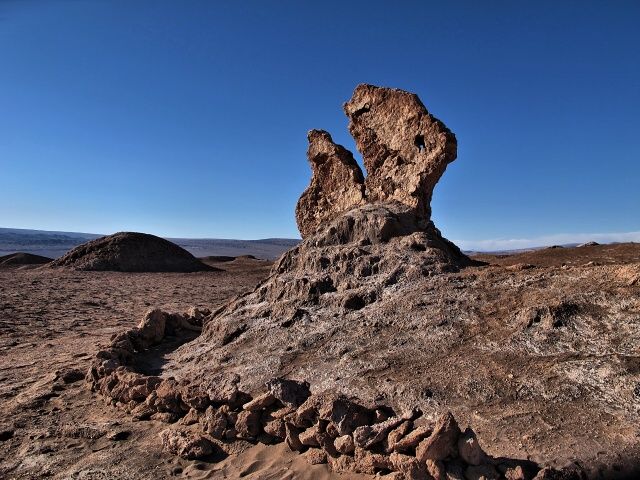
[Valle de la Luna] A rock formation called Dinosaur

[Valle de la Luna] A view of the mountains on the Bolivian border
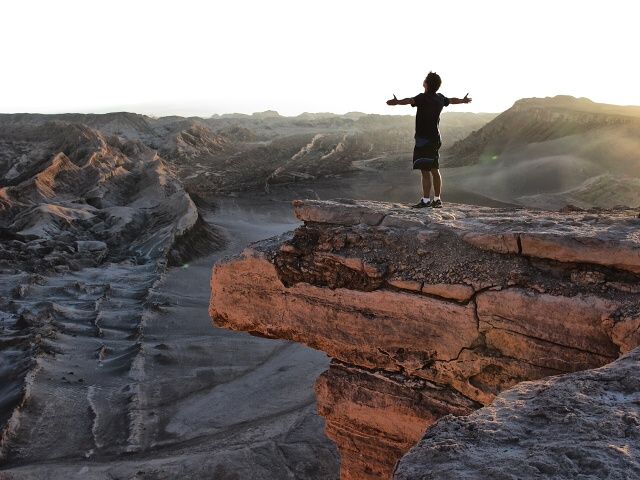
[Valle de la Luna] On the buttress
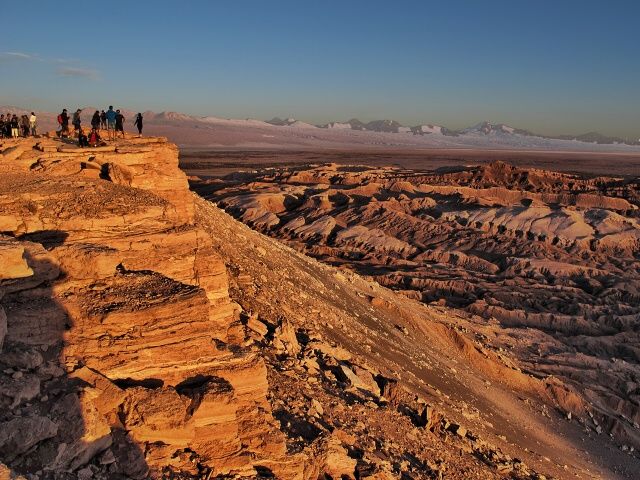
[Valle de la Luna] Waiting for the sunset
El Tatio Geysers
These were on the next day's itinerary. The departure was at 4 a.m. Fortunately, the GPS has a loud alarm clock which is capable of waking me up. It was necessary to reach the 90-km distant geysers, situated at an altitude of 4,300 meters before daybreak, so that the impression of the smoking crater vents would be the best possible. Of course the temperature was below zero. The travel agents had warned us in advance, so some individuals were equipped as if for a 14-day stay in Antarctica. In my sandals, I seemed a bit out of place. After dawn, we were given breakfast, including warm milk and eggs hard-boiled in the geysers. Earlier attempts to use the geysers to produce electricity were interesting. They had not worked well, so the activity was halted. Three years ago, the attempts started anew again, but still without success, so the politicians halted the project, reputedly with regard to the environment. One of the devices was still to be seen there.

[El Tatio Geysers] General view of the geothermal area
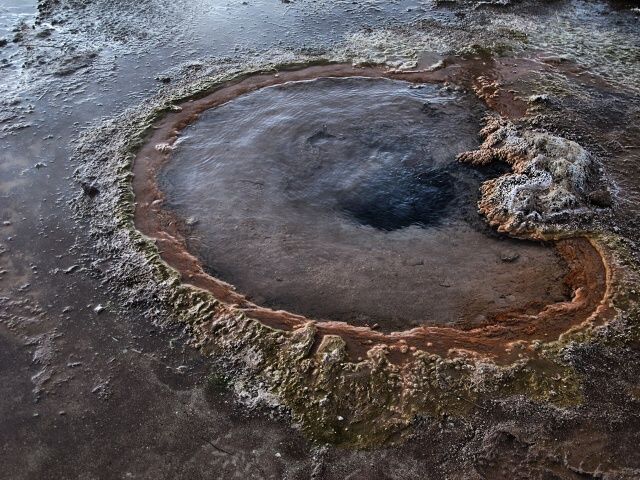
[El Tatio Geysers] A side of the spring coloured by bacteria, which is able to live in these extreme conditions
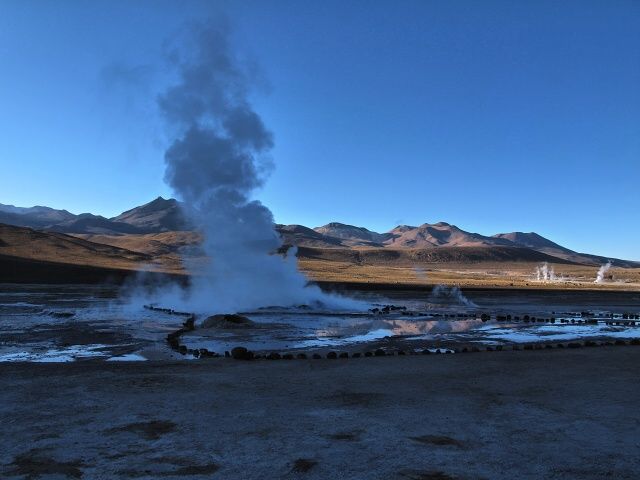
[El Tatio Geysers] One of the geysers
Another attraction which is not for everyone, is a natural warm-water swimming pool. Changing into a swimsuit was a little uncomfortable in the cold, but the swim was good. There were places on the sandy bottom of the pool on which I almost charred my butt, that is how hot it was. But it was really great fun, which I can recommend. Persons sensitive to the cold should keep on the left side where the hot water enters and the temperature is the most pleasant. In the pool, I spoke to a guy from Santiago, who had worked in Europe on IT projects, amongst others, with Czechs. He knew about 20 Czech sentences and had a great friend in Pardubice.
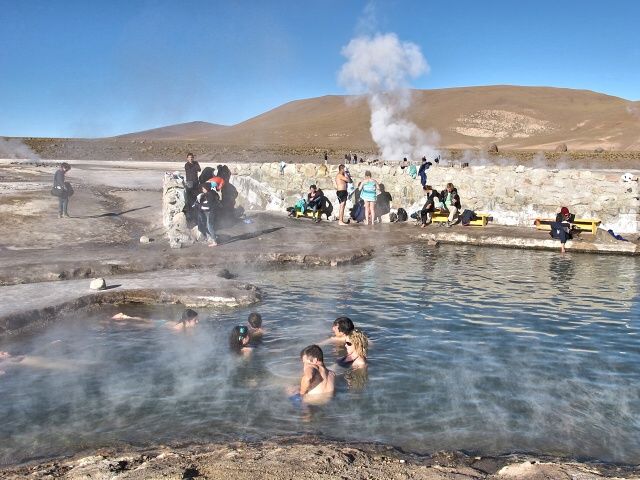
[El Tatio Geysers] A natural pool with thermal water
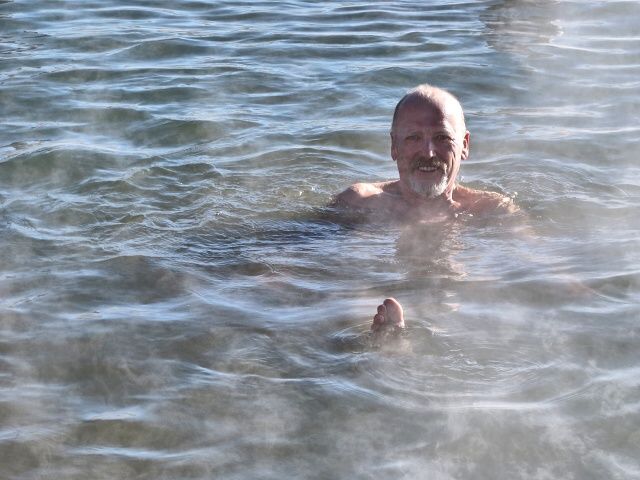
[El Tatio Geysers] A natural hot-water pool (32° C) at 4300 meters; I couldn't miss it
Then we saw some vicunas. There are plenty of them in Bolivia, but somehow I did not get to taking a photo of them (not here, either). Their wool is the most expensive - about 500 USD per kilogram. We observed the construction of duck (or goose) nests on the river and ended the trip in the peculiar village of Machuca. And again I must praise the guide – he really did his best with the bilingual commentary. He told me he had a sister who, with her husband, also devotes herself to long-distance cycling. I explained the problems with the front pannier rack and gave him my visiting card. He promised that his sister would find out whether it was possible to buy the carrier in Santiago and would inform me by e-mail. So I was to wait and see… (she did not write).
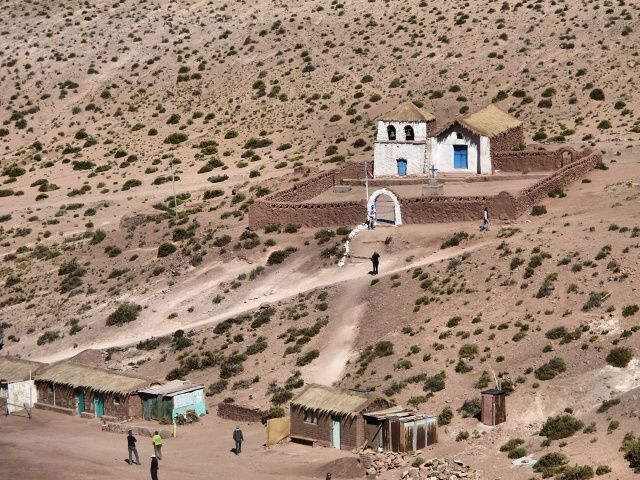
[Pueblo de Machuca] Impressive church looming high above the pueblo
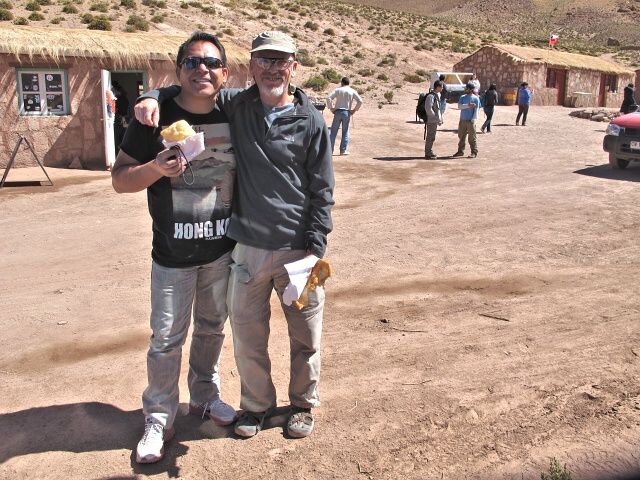
[Pueblo de Machuca] Chilean amigo, he could say several Czech sentences, because he had worked in Europe on some IT projects with Czech people; we consume local empanadas
Back in the Saddle
The road from San Pedro to Calama is simple, first 40 km uphill, and then 60 km downhill. Cycling uphill, I felt that I had not fully recovered from the Bolivian slavery, but that was just a matter of a few days and a few local plates of substantial meat-rich soups. I was looking forward to enjoying the long downhill ride to Calama, but the wind ruined my plans completely. First it blew from 10 o'clock, that was still fine, but in half an hour it turned into a direct impact on the nose. Although the hill was quite steep, I had to put in a great effort to press back against the wind. I arrived in Calama just before sunset. The town has always survived –and still does—from the copper mining in the nearby Chuquicamata Mine of enormous proportions. There are organized excursions to the mine, but it is actually just a hole in the ground, so nothing much to see there. Calama is extremely unattractive, it has no highlight (except for the bronze statue of a miner with a jackhammer). So I slept there, ate, and in the morning set out in the direction of Antofagasta.
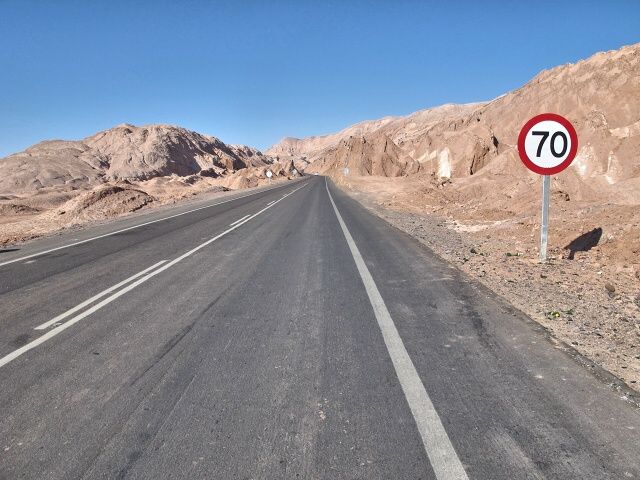
[San Pedro de Atacama] Access road to town among picturesque hills; note the quality road with wide shoulder
The Road from Calama
The road from Calama to the sea is only downhill. It was not blowing in the morning, so I covered the distance like a king, accumulating the miles satisfactorily. I was wondering whether, if it lasted that way, I would break a new long-distance record (currently standing at 195 km per day which I did in Hokkaido, Japan). Well, it did not last. At about noon, the wind started blowing and, of course, it blew directly against me. With a great effort, I cycled 120 km. I stayed overnight in a hostel for drivers at the intersection of Roads 25 and 5. The wind had strengthened, so it made no sense to push ahead. Rather, I would get up early in the morning, and, if there was no wind, would cover in an hour as much as I would have done in three hours against this wind.
Gray Boredom
The Atacama Desert is extremely vast, but offers no enjoyable vistas. It is a brown, clay and sandy plain without any vegetation. The only sign of life consists of monuments to the victims of traffic accidents which are in abundance here. Obviously the trip in the boring environment lulls some people to sleep, resulting in catastrophes. However, the traffic is dense. The port of Antofagasta serves as a major supply point for Bolivia, so the land is really blessed with trucks. Moreover, there was no side strip on about 50 km, so all the time I had to squint into the mirrors and, in the case of any danger, move over into the ditch. There were information boards along the roads, about the excavation of the mines from 1915 to 1940. Nearby were also villages that had been abandoned, after the closure of the mine. Some were extremely large and probably also impressive in their time. But where are the glories of yesteryear, when there is no work in the mine, with the desert providing no opportunity for subsistence?
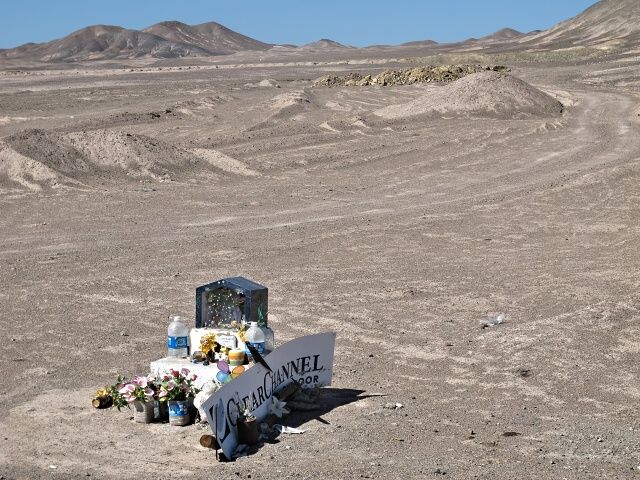
[Near Calama] The boring desert is only enlivened by memorials of road accident victims

[Former pueblo Pampa Unidas] One of the 'ghost cities' - pueblo abandoned after closure of mines
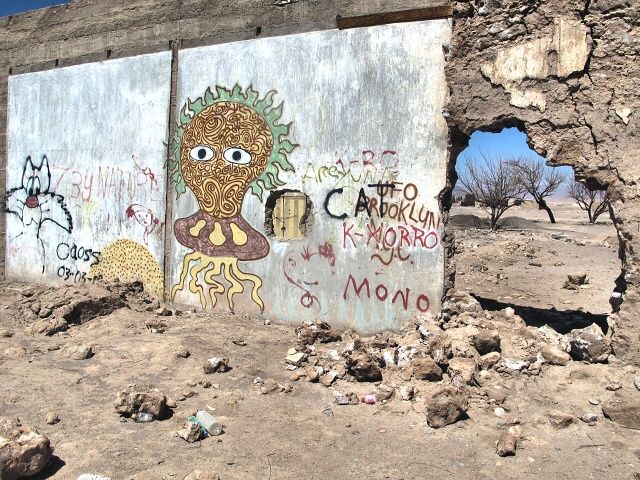
[Former pueblo Pampa Unidas] Graffiti artists practice on walls, but there are too many walls and paint is too expensive
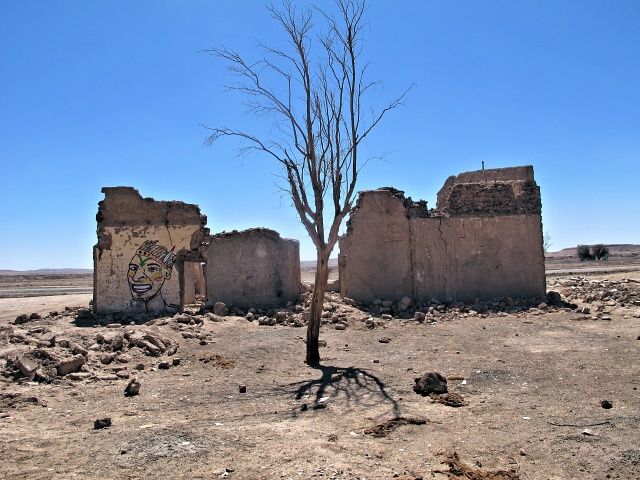
[Former pueblo Pampa Unidas] Isolated trees, which are unusual here, look touching
Escape from the Wind to Antofagasta
It was clear to me that, before noon, the whirlwind would erupt from the sea and move inland again. I set the GPS alarm for 6 a.m. and was ready to go before 7 a.m. However, I found no one in the hostel or in the restaurant who would open the gate for me, although they advertised 24-hour service. The restaurant was open, everything was freely accessible, so they were lucky I am not a thief. Finally I managed to open the front door of the restaurant without damaging it, carried the bike through the dining area and by 7.30 a.m. had already zoomed down the hill in perfect calm. I was surprised by the poor quality of Road 5, which is the backbone of Chilean communication. The road was bumpy, quite broken and without any side strip on 50 km of the total 104 km of its length. Yet I must say that the drivers behaved very well, although trucks sometimes honked their horns, causing me to fall into the ditch. I usually gave them no chance, watching the situation in my mirrors and, in the event that a truck had no space to pass me, intuitively moved off the side of the road and waited. Some cyclists have a different philosophy – "I am a road traffic participant and when a car cannot pass me, it must slow down!" It seems to me that cyclists do not wear enough armor for such an approach.
In the Tropics, just like in Siberia
In the morning, the weather looked good for a while. It was cold, but the sun would warm everything up. About 20 km further on, a fog stretched out, the cold became unbearable and I had to put on leggings and warm gloves. I cycled like this for 50 km, crossing the Tropic of Capricorn and thus finally leaving the tropics for the temperate zone. (BTW - Bolivia did not resemble the tropics either, especially at night). Chileans are constructing a parallel road which might later become a highway. Several kilometer-long sections had already been completed before paving. So I always cycled on those and enjoyed a safe road all to myself. The scenery was like the previous day, nothing to be seen, only in some places it was livened up by piles of excavated earth of toxic colors.
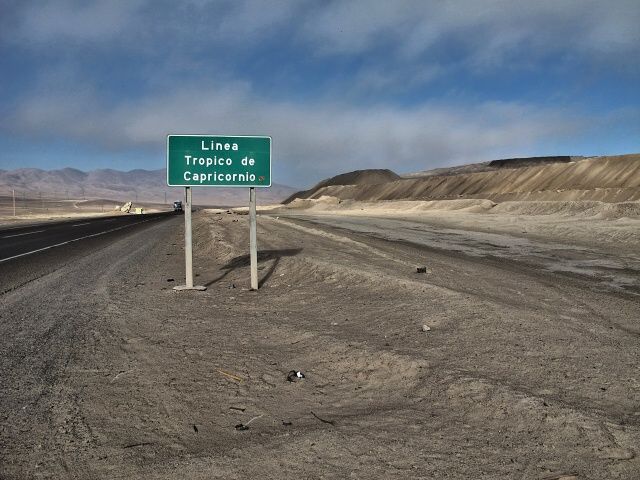
[Near Antofagasta] The Tropic of Capricorn, the end of the tropics
I barely made it
At 11.30 a.m., it started to blow and I was 15 km away from the town. For about 5 km I struggled with a headwind, then the road tilted from the coastal mountains. Even the heavy wind could not beat the steep descent. Suddenly I was in Antofagasta and began a search for suitable accommodation. In my GPS, I had three places entered according to the guidebook, which for me was a new, very pleasant experience. But the result was dismal, all of them were reportedly full (it is possible because it was a Friday, but probably rather that my appearance repulsed them). In the last of the three hotels I was advised to check across the road, that there was an accommodation facility too. And it turned out ultimately the best choice. A standard room, big enough for the bed and bike. But most importantly, the lady of the house cooked fantastically and the whole street came to her for meals. For 2000 Pesos (about 4 USD) I had lunch – soup, main course, dessert, juice. I complimented her, saying that her food was just like my mother's, and this, as you know, is the highest compliment to any cook. And she indeed favored me and I got big portions.
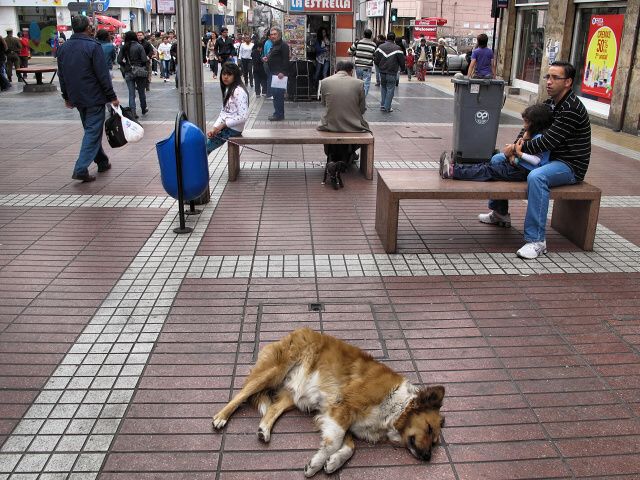
[Antofagasta] Typical Chile: dogs everywhere, even in the pedestrian zone in the city center
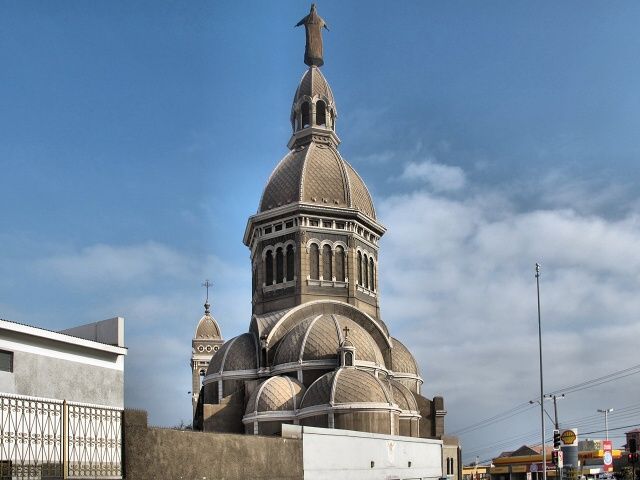
[Antofagasta] Basilica Corazón de Maria – a huge statue of Our Lady on top of the highest spire
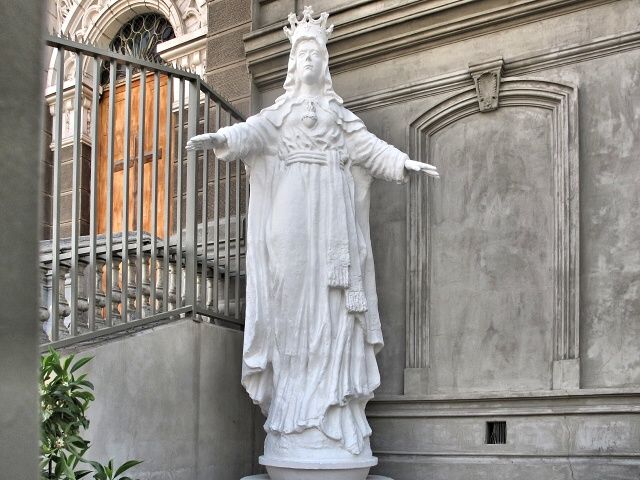
[Antofagasta] Basilica Corazón de Maria – a copy of the statue is in front of the basilica
Good Luck, As Always
When I was touring the accommodation facilities, I met a guy in Ossa Street, sitting on the sidewalk, putting the spokes into a new wheel. Behind him was a small bike store, so I asked him if he had a front pannier rack. "Yeah, I have something there, check it out," he replied. And there was the same carrier, only it was not a Blackburn brand, but some no-name Chinese imitation. I said I would come back later. Then I asked at the tourist information about bike stores and this little store was the best-known and actually the only bike store in town. I also needed to drill holes in the pannier rack for the closing of the bags, so I took the bike and front bags and went to arrange it. I came to an agreement with the owner (the guy on the sidewalk). I left my bike there and he said it would be ready the next day. On the next day, the bike was ready after noon. The owner charged me only the price of the carrier (about 17 USD). His labor was free. He said he had checked my website and when he read about my trip through Bolivia, he did not feel so good. He said that he had cycled in Calama at an altitude of 2,500 meters and was absolutely exhausted. I at least gave him a tip equal to the price of the pannier rack and he was happy.
Antofagasta
This is not a tourist pearl, and I also saw almost no tourists there. Chile’s second largest city (less than 400,000 inhabitants), a major port supplying mainly Bolivia. Nice main square, a few nice houses around it, from the 19th century in British style. But mostly, a multitude of stores, supermarkets, restaurants, a large marketplace, everything one needs for daily living. I thought I would swim in the Pacific. El Paraiso beach is near the center, with sand which had been brought in. However, the water was still cold and so I did not go into the sea.

[Antofagasta] Central plaza – a copy of Big Ben (but smaller); the Cathedral in the background
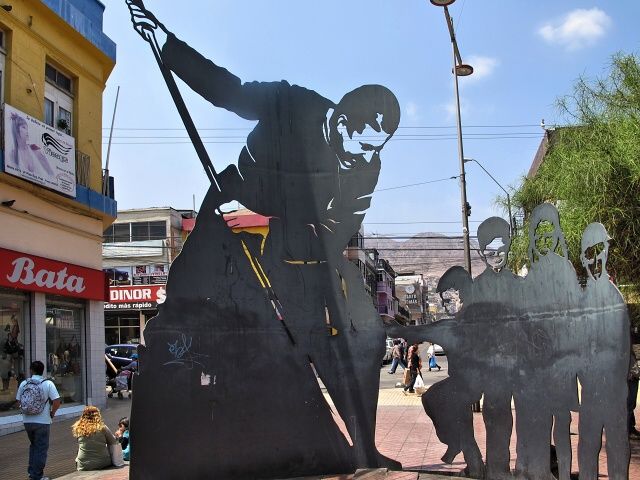
[Antofagasta] Two-dimensional statue in the Prat Street pedestrian zone

[Antofagasta] Town stretches along under the coastal mountains
Fish Market
The fishing harbor is a short walk from the center. The spectacle is amazing. There are seals frisking around in the water messing with the garbage, pelicans fighting for remnants of fish. A strong smell of fish and rotting seaweed. And still small fishing boats were arriving with fresh catches, larger fish had string threaded through their gills for easier handling. The adjacent building contained many stalls offering salads with fresh ingredients – mussels, shrimp, fish, and heaven knows what else. Everyone was a gourmet there, it looked good – vegetables and seafood, but I did not have confidence and was afraid that I would get ill from the unusual food. Well, I did not. First I tasted at a few stalls and then had a wonderful salad of shrimp, strongly flavored with lime.
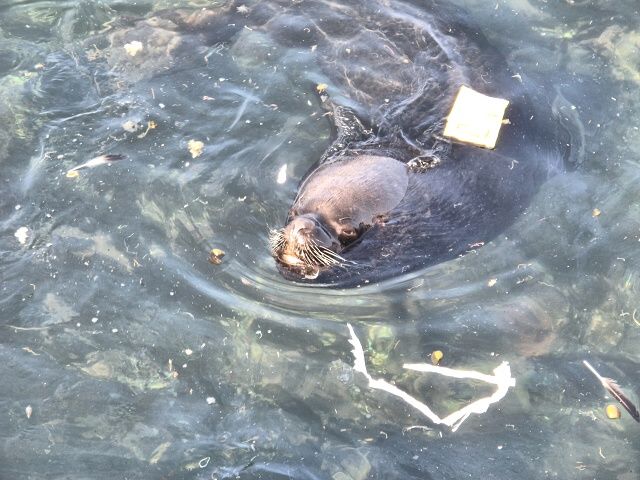
[Antofagasta] Seals frisking among the garbage in the port
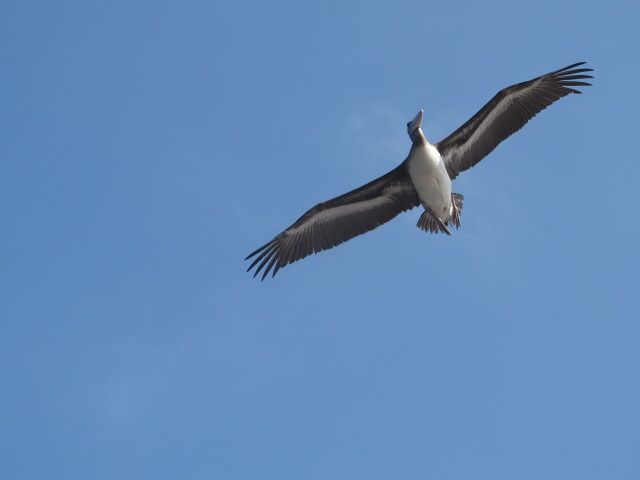
[Antofagasta] Pelicans viewing it from above
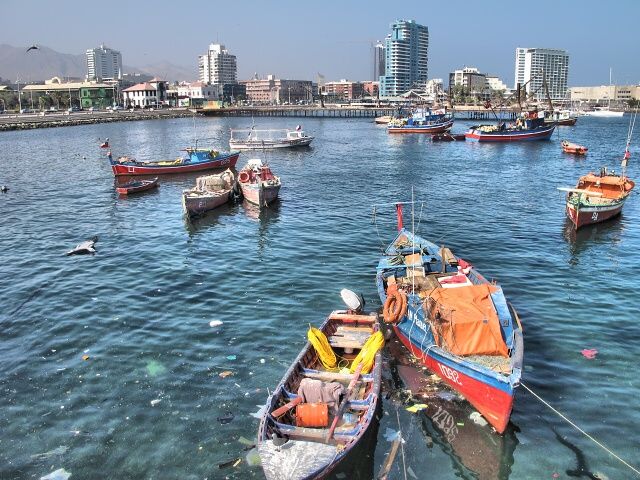
[Antofagasta] Fishing port
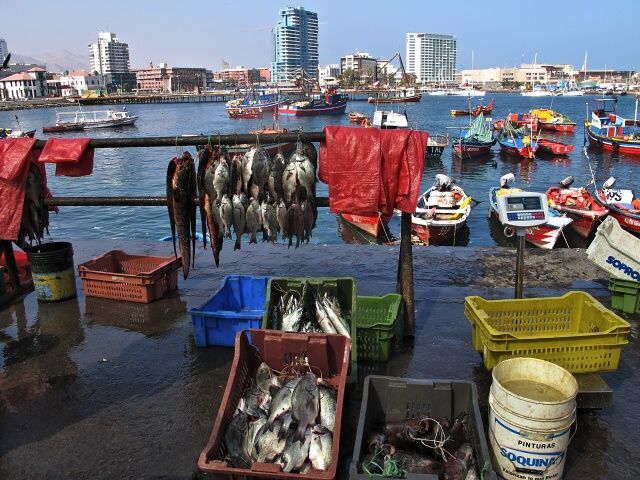
[Antofagasta] Fish market – with a wide selection
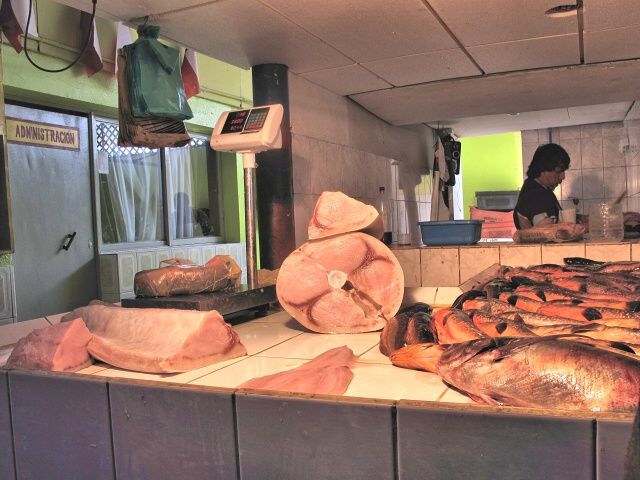
[Antofagasta] Pretty tuna steaks – yummy!

[Antofagasta] Fish market – pelicans waiting for fish remains
Gormandize to be as Strong as an Ox
I saw myself in a mirror from the waist down. Bolivia had blown off my Michelin tire around the stomach to an absolute minimum. For practical reasons, I would have to wrap myself in a bit of fat again. Fortunately, there were countless opportunities for this. In the 20-minute walk to the center I came across three supermarkets (as big as Tesco in Prague’s Zlièín) and a large marketplace. And so I gormandized as much as I could. When times are good, one must build up a fat layer. Primeval men were well aware of this.
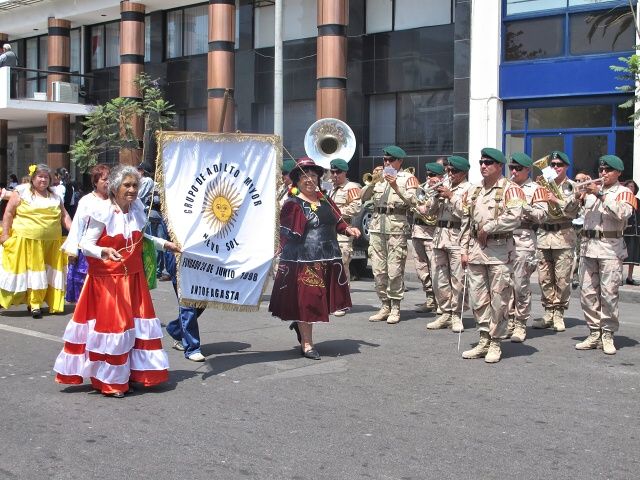
[Antofagasta] Retired people had a parade; a military brass band was playing
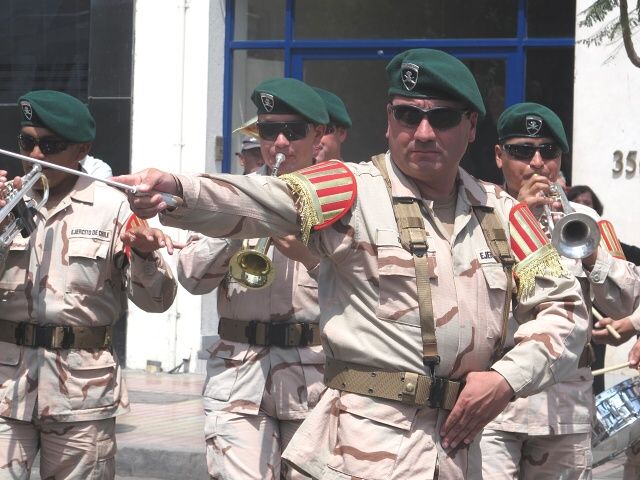
[Antofagasta] I wanted to join the parade but I was clearly kicked out by the bandmaster – I guess I should have shown him my passport with my date of birth
To Santiago
On Sunday at noon, I was to take a bus for the 18-hour journey to Santiago. The Atacama Desert stretched out far ahead and there are far nicer places in Chile, so why waste time? It was not easy, two companies kicked me out before Tur Bus agreed to transport my bike. However, I would still at least have to remove the pedals and turn the handlebars around. But it is well-known that the best method is to give a small baksheesh to the porter and everything would go smoothly. I was soon to find out …

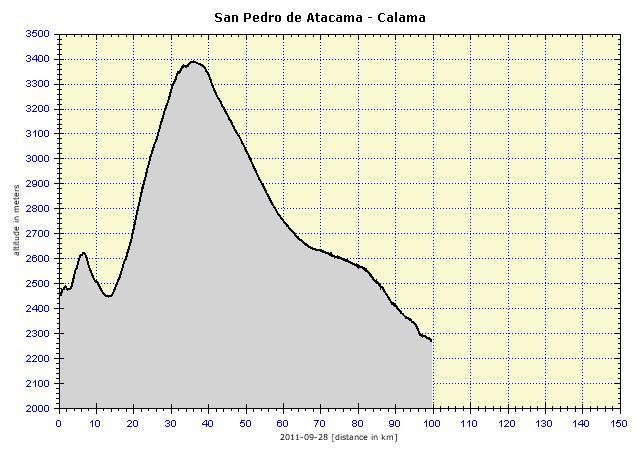
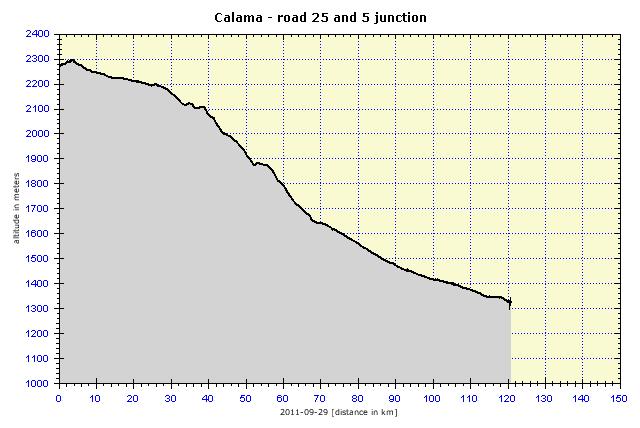
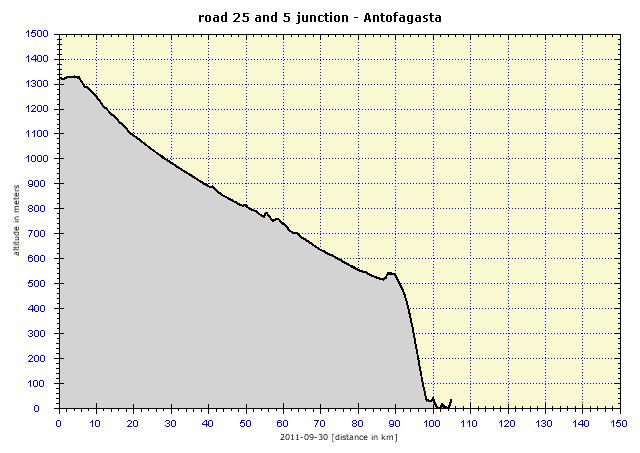
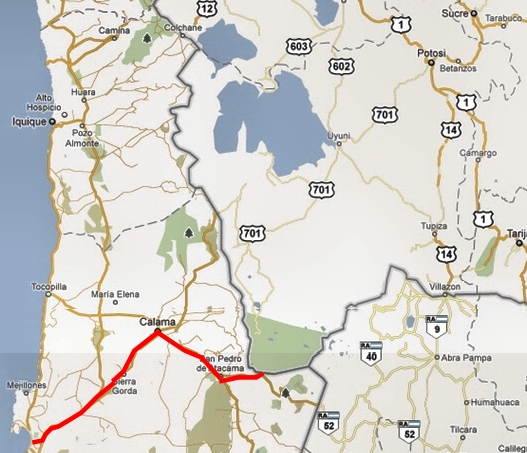
| 



















































